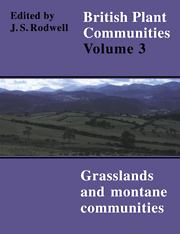Book contents
- Frontmatter
- Contents
- List of Figures
- Preface and Acknowledgements
- Preamble
- Mesotrophic Grasslands
- Community Descriptions
- Calcicolous Grasslands
- Community Descriptions
- Calcifugous Grasslands and Montane Communities
- Community Descriptions
- Index of Synonyms to Grasslands and Montane Communities
- Index of Species in Grasslands and Montane Communities
- Bibliography
CG4 - Brachypodium Pinnatum Grassland
Published online by Cambridge University Press: 04 July 2020
- Frontmatter
- Contents
- List of Figures
- Preface and Acknowledgements
- Preamble
- Mesotrophic Grasslands
- Community Descriptions
- Calcicolous Grasslands
- Community Descriptions
- Calcifugous Grasslands and Montane Communities
- Community Descriptions
- Index of Synonyms to Grasslands and Montane Communities
- Index of Species in Grasslands and Montane Communities
- Bibliography
Summary
Synonymy
Chalk grassland auct. angl. p.p;; Brachypodium pinnatum grassland auct. angl.; Cirsio-Brometum brachypodietosum Shimwell 1968a.
Constant species
Brachypodium pinnatum, Carex flacca, Festuca ovina.
Rare species
Astragalus danicus, Herminium monorchis.
Physiognomy
This community includes all swards in which B. pinnatum exceeds 10% cover in the virtual absence of other bulky tussock grasses such as Bromus erectus and Avenula pubescens. Like the Bromus grassland, it takes in vegetation which is similar to the Festuca-Avenula grassland as well as some much ranker swards but it is somewhat poorer overall in Festuca-Avenula species than the Bromus grassland, its general floristics being shifted somewhat towards more mesotrophic grasslands. Only two associates attain constancy throughout, Carex flacca and Festuca ovina and, of the frequent species, only Sanguisorba minor, Linum catharticum and Briza media are stricter Mesobromion plants. As well as being often too rank to offer a congenial site for more diminutive rarities, many stands occur outside the range of the Continental element in British calcicolous grasslands.
Sub-communities
Avenula pratensis-Thymus praecox sub-community. Although B. pinnatum is almost always the most abundant species here, sometimes growing as conspicuous tussocks, its cover is often patchy and, between the clumps, less coarse grasses, such as Festuca ovina, Avenula pratensis, Briza media and Koeleria macrantha, and chamaephytes, notably Thymus praecox and Helianthemum nummularium, occur frequently and sometimes with local abundance. Cirsium acaule and Asperula cynanchica are preferential to this sub-community. Many of the swards included here, especially those from colonised quarry spoil, are also somewhat open and on patches of bare soil there are occasional records for a variety of pauciennials, such as Euphrasia officinalis agg., Carlina vulgaris, Blackstoniaperfoliata, Inula conyza, Centaurium erythraea and annual Hieracia, and bryophytes like Weissia cf. microstoma, Fissidens cristatus, Ctenidium molluscum, Campylium chrysophyllum and Pseudoscleropodium purum. Anacamptis pyramidalis is sometimes conspicuous in this kind of vegetation.
Centaurea nigra-Leontodon hispidus sub-community. Some Mesobromion dicotyledons, such as Helianthemum nummularium, Sanguisorba minor and Linum catharticum, remain frequent in this sub-community but the taller and ranker swards are generally more overwhelmingly dominated by B. pinnatum and the most obvious features of the vegetation are the frequency of the taller hemicryptophytes Leontodon hispidus, Centaurea nigra and Knautia arvensis and the increasing prominence of more mesophytic species such as Plantago lanceolata, Bellis perennis, Trifolium pratense, Trisetum flavescens and Holcus lanatus. Ononis repens occurs occasionally.
- Type
- Chapter
- Information
- British Plant Communities , pp. 178 - 183Publisher: Cambridge University PressPrint publication year: 1992

